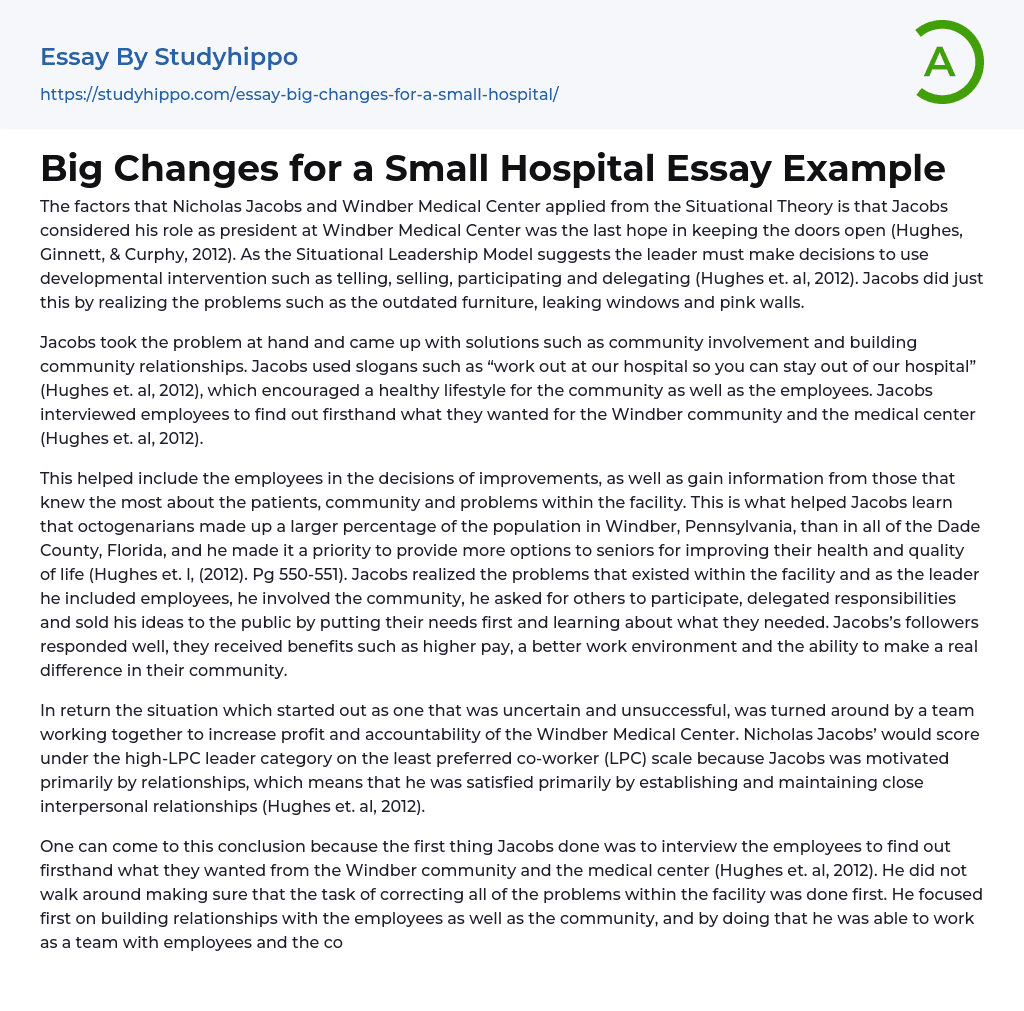The factors that Nicholas Jacobs and Windber Medical Center applied from the Situational Theory is that Jacobs considered his role as president at Windber Medical Center was the last hope in keeping the doors open (Hughes, Ginnett, & Curphy, 2012). As the Situational Leadership Model suggests the leader must make decisions to use developmental intervention such as telling, selling, participating and delegating (Hughes et. al, 2012). Jacobs did just this by realizing the problems such as the outdated furniture, leaking windows and pink walls.
Jacobs took the problem at hand and came up with solutions such as community involvement and building community relationships. Jacobs used slogans such as “work out at our hospital so you can stay out of our hospital” (Hughes et. al, 2012), which encouraged a healthy lifestyle for t
...he community as well as the employees. Jacobs interviewed employees to find out firsthand what they wanted for the Windber community and the medical center (Hughes et. al, 2012).
This helped include the employees in the decisions of improvements, as well as gain information from those that knew the most about the patients, community and problems within the facility. This is what helped Jacobs learn that octogenarians made up a larger percentage of the population in Windber, Pennsylvania, than in all of the Dade County, Florida, and he made it a priority to provide more options to seniors for improving their health and quality of life (Hughes et. l, (2012). Pg 550-551). Jacobs realized the problems that existed within the facility and as the leader he included employees, he involved the community, he asked for others to participate, delegated responsibilities
and sold his ideas to the public by putting their needs first and learning about what they needed. Jacobs’s followers responded well, they received benefits such as higher pay, a better work environment and the ability to make a real difference in their community.
In return the situation which started out as one that was uncertain and unsuccessful, was turned around by a team working together to increase profit and accountability of the Windber Medical Center. Nicholas Jacobs’ would score under the high-LPC leader category on the least preferred co-worker (LPC) scale because Jacobs was motivated primarily by relationships, which means that he was satisfied primarily by establishing and maintaining close interpersonal relationships (Hughes et. al, 2012).
One can come to this conclusion because the first thing Jacobs done was to interview the employees to find out firsthand what they wanted from the Windber community and the medical center (Hughes et. al, 2012). He did not walk around making sure that the task of correcting all of the problems within the facility was done first. He focused first on building relationships with the employees as well as the community, and by doing that he was able to work as a team with employees and the community to make Windber a chosen facility that addressed issues the community faced.
Based on the success of Windber, the range that one may guess the overall situational favorability might fall for Jacobs on the continuum is as follows: Leader-member relations: Good; Task structure: Structured; Position power: High; and Octant: 1. One may choose these ranges because Jacobs’ leader-member relations were so high and those carry so
much weight that his success at building relationships was so favorable in the success of the Medical center that the other ranges were high due to his ability to ensure that leader-member relations were of great importance from the beginning.
Nicholas Jacobs knew the challenges that were to come when he accepted the position as president at Windber Medical Center. He was determined to make the changes needed to keep the doors open for the Windber community. His leadership skills were prevalent in including all that were involved in making the Medical Center a success. He did a wonderful job at raising money, involving community stake holders as well as employees in the transformation. In return he helped build a facility back up that was focused on the needs of the community as well as those employed there.
- Academia essays
- Higher Education essays
- Language Learning essays
- Studying Business essays
- Education System essays
- Study essays
- First Day of School essays
- Scholarship essays
- Pedagogy essays
- Curriculum essays
- Coursework essays
- Studying Abroad essays
- Philosophy of Education essays
- Purpose of Education essays
- Brainstorming essays
- Educational Goals essays
- Importance Of College Education essays
- Brown V Board of Education essays
- The Importance Of Higher Education essays
- Online Education Vs Traditional Education essays
- Academic And Career Goals essays
- Academic Integrity essays
- Brown Vs Board Of Education essays
- Distance learning essays
- Technology in Education essays
- Vocabulary essays
- Writing Experience essays
- Importance of Education essays
- Early Childhood Education essays
- Academic Degree essays
- Academic Dishonesty essays
- School Uniform essays
- Academic writing essays
- Cheating essays
- Bachelor's Degree essays
- MBA essays
- College Life essays
- Grade essays
- Diploma essays
- Phonology essays
- Sentence essays
- Filipino Language essays
- Pragmatics essays
- Millennium Development Goals essays
- History Of Education essays
- Graduate School essays
- Middle School essays
- School essays
- Special Education essays
- University essays




